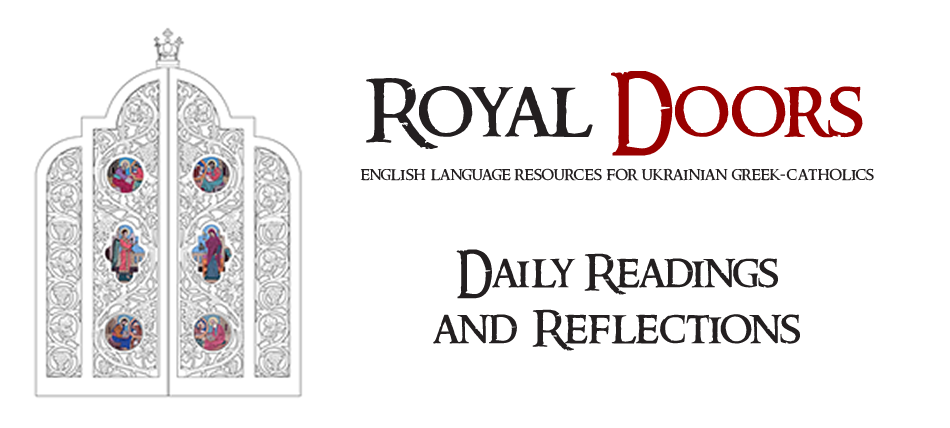![]() The New Testament says nothing about the early life of Jesus’ Mother. But in the Church’s tradition, Mary, like other significant people in the history of Israel, was born by the direct intervention of God. According to the second-century Protevangelium of James, her parents, Joachim and Anna, were righteous but childless. Once when Joachim, a rich man, went to the temple to offer his gifts to the Lord, he was not allowed to do so, because he had not raised up offspring in Israel. Saddened by this rejection, he researched to see whether all the righteous in Israel had had children. He found they all had, including Abraham, to whom God gave a son in his old age. With him in mind, Joachim went into the wilderness, saying nothing to his wife, and fasted with prayer for forty days.
The New Testament says nothing about the early life of Jesus’ Mother. But in the Church’s tradition, Mary, like other significant people in the history of Israel, was born by the direct intervention of God. According to the second-century Protevangelium of James, her parents, Joachim and Anna, were righteous but childless. Once when Joachim, a rich man, went to the temple to offer his gifts to the Lord, he was not allowed to do so, because he had not raised up offspring in Israel. Saddened by this rejection, he researched to see whether all the righteous in Israel had had children. He found they all had, including Abraham, to whom God gave a son in his old age. With him in mind, Joachim went into the wilderness, saying nothing to his wife, and fasted with prayer for forty days.
His wife Anna, too, mourned her childlessness and her presumed widowhood. At the prompting of her maid Judith, just before the great day of the Lord, she exchanged her mourning for bridal clothes, and sat down under a laurel tree in her garden. Remembering Sarah, she lamented that she was barren, and prayed to God for a child. An angel of the Lord appeared to her, and told her that her prayer had been heard. She would conceive and give birth to a child, whose fame would spread throughout the world. Anna promised that any child she bore would be given to the Lord and serve him all its life. Two angels told her that her husband was on his way, and had been told by an angel of the Lord that his wife would conceive.
Meanwhile an angel of the Lord had appeared to Joachim, too, and told him his prayer also had been heard. His wife would conceive. He took lambs, calves and goats from his flocks as an offering to the Lord, on his own behalf and on that of the priests and elders, and all the people, and went back to Jerusalem. Anna was standing at the gate, and when she saw him coming she ran and embraced him, and said “Now I know that the Lord God has greatly blessed me; for behold the widow is no longer a widow, and I, who was childless, shall conceive.”
When Joachim offered his gifts at the altar the next day, he knew, from the appearance of the priest’s frontlet (an oracular plate) that he had been forgiven and justified. In due time, Anna gave birth to a baby girl and named her Mary.
The themes of the texts for the feast of the birth of Mary are largely derived from this story in the Protevangelium of James. The language in which these themes are presented is that of the fully developed doctrine of the incarnation, formulated by the third and fourth ecumenical councils, of Ephesus in 431 and Chalcedon in 451.
The icon of the feast is reminiscent of that of the birth of Jesus Christ. Anna is depicted lying on a couch, with attendants nearby, while one or two maids wash the new-born child in a basin. The infant is also shown, wrapped in swathing bands and lying on a small couch next to Anna’s bed. Sometimes she is depicted in a cradle, rocked by another maid. From a window Joachim looks down on the scene.
Some texts from Vespers:
The spiritual beams of the whole world’s rejoicing, have shone upon the lands at your birth, pure Lady, foretelling to all the Sun of glory, Christ our God. For you have shown yourself mediator of true rejoicing and of grace.
Your worshipful birth, most pure and holy Virgin, heaven’s angelic hosts and human race on earth combine to praise. For you became Mother of Christ our God, the creator of all. We pray you, intercede incessantly with him for us, who, next to God, in you have placed our hopes, Mother of God unwedded and highly praised.
Source: Hugh Wybrew, Orthodox Feasts of Jesus Christ and the Virgin Mary: Liturgical Texts with Commentary (Crestwood, New York: St. Vladimir’s Seminary Press, 2000), 23-25.

2 comments